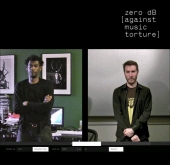Between the rows and break-ups, Massive Attack have always worked with their friends and heroes. So, as Robert Del Naja tells Phil Johnson, curating the Southbank Meltdown season is business as usual
As portfolios go, it is a rather slim one. Since their first, independently produced single "Any Love" in 1988, Massive Attack – whose Southbank Meltdown season begins on Saturday, when they play the first of two performances at the Royal Festival Hall – have released only four albums of original material. A fifth is promised later this year, but, given the glacial pace at which the band work, "later" can mean a very long time.
Calling the two remaining members a band might also be misleading, for Massive Attack has never been a calloused-fingered collective of co-instrumentalists. "You're meant to perform and we don't," Robert Del Naja (aka 3D) told me for my 1996 book on the Bristol sound, Straight Outa Bristol. Instead, Massive Attack operated as a loosely defined production base, using various collaborators to help them complete their ideas. As the three founding members recalled around the time of their second album Protection (1994), they might get the recording engineer to fine-tune a synth sound by telling him: "Like, a bit more phwaah, please."
Del Naja, now 43 and the group's principal presence, also surprised fans by referring to Massive Attack at the time of the last album, 100th Window (2003), not as a band, but as a brand. By then, he was the only working member, Andrew "Mushroom" Vowles having left shortly after Mezzanine (1998) and Grant "Daddy G" Marshall, 48, taking extended paternity leave.
But while Massive Attack's portfolio may be slim and the exact contributions of the group-members difficult to pinpoint, their work remains impressive, with two all-time classic albums in Blue Lines (1991) and Protection and a visual identity that has always looked the part: the group were photographed by the fashion photographers Juergen Teller and Jean-Baptiste Mondino, and filmed by director Baillie Walsh (who was behind the video for "Unfinished Sympathy"). The differing ethnicities of the three original members also helped to fulfil a multicultural fantasy of cool dudes walking tall. As it turned out, they could barely stand to be in the same room, at least when it came to recording.
Yet, if Massive Attack once lacked muso-credibility, who now cares? In a world of "virtual" bands such as Gorillaz, co-founded by Del Naja's friend Damon Albarn, Massive's moody mix of music and visuals fits in as perfectly postmodern. Although they confronted the difficulties of appearing live years ago, and their Meltdown appearances form part of a long European tour of major venues, it's perhaps useful to regard Massive Attack as curators first and creators second. This, of course, makes their new role particularly appropriate. With Meltdown, they get the chance to curate on a scale previously undreamed of. Their wide-ranging programme (they're the festival's 15th incumbents) also hangs together unusually well.
"Yeah, it's every boy's treat but it comes with a price," Del Naja says. "You're following up a lot of really great curators and you don't want to be the first to fuck it up."
He also agrees that the world has started to come round to Massive's way of doing things. "We're in funny times," he says. "When we started, we were music fans swapping C90s and C60s [cassette tapes], chopping and changing tracks and distorting them, and the whole culture is like that now. But we were also a contradiction because, despite being like that, with our first album we wanted everyone to experience the purity of an unbroken sequence of tracks. So we've moved with the times and the times have moved with us. It was never just four or five people on stage."
As to whether they are a band or a brand, he's ambivalent. "The Massive Attack concept wasn't a fully formed thing, right from the beginning, and it's never really changed since then, never been a solid situation," he says. "There's an insecurity there, but also a freedom and you can switch them off and on. The obvious examples are Radiohead and Blur with Damon. As they've moved forward they've explored every possibility, politically as well as musically, and we've always been slightly ambiguous. It's like when the Sex Pistols changed to PiL, that was a big change, you know?"
Massive's Meltdown season reflects their roots and often disparate influences very effectively, from punk rock, reggae and the rebel chic of Detroit's MC5, to black music stars from past and present (including Terry Callier, Grace Jones, George Clinton, the new hip-hop and dub-step generations), and fellow pop aristocrats Primal Scream and Elbow.
The band's radical and anti-war credentials ("I've always been a bit of a red," Del Naja says) are honoured in a number of films and events, while the season also includes a screening of Shane Meadows' new movie Somers Town, a concert performance of Vangelis's score for Ridley Scott's Blade Runner (there are also two showings of the film at the BFI's IMAX cinema), and screenings of Massive Attack's often innovative pop videos.
Indeed, Massive Attack, and the group from which they emerged in 1987, Bristol's The Wild Bunch, were always about more than just music; they represented the new hip-hop culture's effect on everything from graffiti art (3D was an influence on his friend and fellow artist Banksy) to computer games and film. With The Wild Bunch (named, of course, after Peckinpah's ultraviolent western), the way they looked was probably more important than how they sounded.
The Wild Bunch members (Miles Johnson, Nellee Hooper and Claude Williams as well as Massive Attack's three founders) were obsessed with gangster movies and splatter flicks. They revered Scorsese's Taxi Driver, called each other "Jack" like the characters of a Mean Streets street gang, and screen-printed their own Robert De NiroT-shirts (the Mohican, gun-to-head image, naturally). When Del Naja was arrested in 1984 for spray-painting illegally, he was still holding the paper pattern for the Taxi Driver mural he was working on.
Later he would describe his method of writing lyrics as, "like travelling through a crowded bar and stopping for a few moments at each conversation and listening to bits and pieces." In other words, not unlike Ray Liotta entering the mob's club in Goodfellas.
As a lecturer at a local college, I at one point found myself teaching odd bits of film and video to Del Naja and Vowles. Ever since, I've thought Del Naja might become a director. "It's true I was really excited about it, wanted to go to art college and film school," he says. "Then I got diverted by graffiti and the Wild Bunch thing. But I know how obsessive it becomes. On the whole, my experience with films hasn't been a positive one. More the opposite: you're entirely at the mercy of the producer and director."
He gives the example of a track he wrote with Liam Howlett of The Prodigy for Danny Boyle's The Beach, which he's glad was never used. "If we'd seen every scene of every film Massive Attack's music is used in, we would have said no to all of it," he says. "I've spent 20 years relinquishing that desire [to work with film]."
Yet, to look at it another way, maybe he didn't really relinquish the desire to be a filmmaker at all, but merely reapplied it to music, directing Massive Attack's albums in the same way an auteur directs a film: choosing suitable collaborators, casting each role and spending very long periods in post-production. Seen like this, four major projects in 20 years, with a fifth yet to wrap, doesn't seem too bad a record at all.
Meltdown runs from Saturday to 22 June at the Southbank Centre, London SE1 (tel: 0871 663 2520, www.southbankcentre.co.uk)
That's Massive: Meltdown must-sees at the Royal Festival Hall
Yellow Magic Orchestra The first UK performance since 1980 for the legendary Japanese techno trio from the Tokyo cultural scene that was a big influence on Massive Attack in the early days. 15 June
Vangelis's Blade Runner soundtrack Performed live by the Heritage Orchestra and mixed by Massive. The sci-fi film is a key text for the band, which adapted its broken aesthetic to create similarly scratched and fissured music. 17 June
Stiff Little Fingers, Mark Stewart & the Maffia, Adrian Sherwood Massive honour their punk and reggae roots, with Belfast's Stiff Little Fingers joined by Adrian Sherwood and Mark Stewart, a Godfather of the Bristol scene. 18 June
Grace Jones The stroppy disco queen's early 1980s albums, with a reggae rhythm section of Sly Dunbar and Robbie Shakespeare, helped to define the confluence of styles Massive later worked with. 19 June








